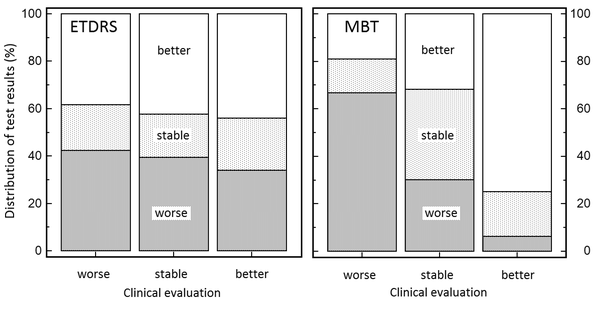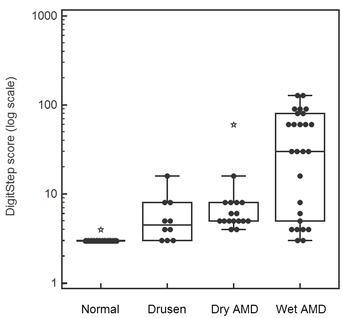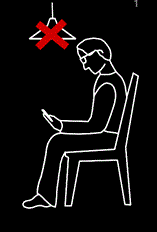
The DigitScreen test was expressly devised as a screening tool. A graded assessment of various degrees of visual loss requires a larger number of test targets, with larger numbers of rarebits per digit segment, and active examiner control over target presentations. The DigitStep test was devised to meet these requirements in a personal computer setting.
This test presents pairs of randomly selected segmented digits in random screen locations. The pair members are shown with a slight delay in-between. This arrangement makes for a simple test task and a large target area.
There are 11 preset test levels, comprising different numbers of rarebits per digit segment. These numbers are 3, 4, 5, 6, 8, 10, 16, 30, 60, 90 and 128. Change test level by tapping the UP or DOWN arrow keys on the keyboard. The current test digits are replicated in a non-distracting way in the upper left corner of the screen, together with the current rarebit numbers. For example, 12:16 means digits 1 and 2, and 16 rarebits per segment.
The subject's task is simply to call out any digits seen. Guessing is encouraged. There are no fixation demands. The examiner’s task is to find the lowest test level were the subject can read minimum 3 digits in maximum 3 presentations. No more than 3 presentations are allowed at any test level.
Most normal subjects will manage level 1, that is, 3 rarebits per segment but some elderly subjects may need level 2, that is, 4 rarebits per segment. Subjects with advanced visual loss may fail to see the highest level, forcing a switch to a test more tolerant to damage, for example, an ordinary acuity test.
Use a stand-alone liquid-crystal display (LCD) with a diagonal of ≥15" and a vertical resolution of ≥800 pixels. The test uses the central 1024 x 768 pixels only. Laptop displays are not recommended because of their lower contrast. Use the screen manufacturer's default settings for resolution, brightness and contrast. The browser borders and any display indicator lights need to be masked to prevent disturbing stray light. The most practical solution may be to lean a cut-out cardboard mask against the front of the display. The test space should be completely dark. Arrange for comfortable viewing at 4 m distance. Cover one eye. Use a proper ametropia correction.
The test area subtends ca. 4.5 x 3.5° at 4 m test distance, the test digits subtend ca. 0.6 x 0.8° (= 0.1 decimal, 20/200 Snellen), and the multibits ca. 0.5', assuming a pixel size of ca. 0.3 mm. Presentation time is 150 milliseconds.
DigitStep needs a 4-meter test distance. Paradoxically, the test becomes increasingly difficult with shorter distances and is almost undoable at a reading distance.
The DigitStep test has been studied in the setting of age-related macula degeneration (AMD). 37 patients with various stages of AMD and 25 control subjects participated in the evaluation, which also included the ETDRS acuity test. Analysis of receiver-operating characteristics indicated significantly better discrimination by the rarebit test (p = 0.01) and rarebit numbers >16 appeared to reliably indicate the presence of macula edema. Sensitivity was estimated to 91% at 90% specificity. ETDRS sensitivity was estimated to 75%. See [4] for full details.

 Management of AMD patients is well known to pose a major logistic challenge. Management might be optimized by involving patients themselves in serial vision testing, at home. Modern smartphones and electronic tablets provide a practicable and widely available technical platform for self-testing. Given the good results obtained with the DigitStep test, and particularly its sensitivity to macula edema, transformation to a smartphone/tablet application or "app" format should have merit. The test platform must meet the rarebit specification (pixel subtense <1') at a practicable (= laptop) test distance. Apple's iPhone/iPod Retina Screen platform was used here.
Management of AMD patients is well known to pose a major logistic challenge. Management might be optimized by involving patients themselves in serial vision testing, at home. Modern smartphones and electronic tablets provide a practicable and widely available technical platform for self-testing. Given the good results obtained with the DigitStep test, and particularly its sensitivity to macula edema, transformation to a smartphone/tablet application or "app" format should have merit. The test platform must meet the rarebit specification (pixel subtense <1') at a practicable (= laptop) test distance. Apple's iPhone/iPod Retina Screen platform was used here.
The MultiBit Test (MBT) app cycles segmented digits in carefully worked-out sequences. There are no fixation demands. The test task is to spell out loud all digits seen. The responses are recorded in an internal audio file. At the end of the test, the digits shown during testing are presented in an easily read format, and the subject checks these digits against the recorded responses. The test score is calculated as the per cent correctly read digits. Scores can easily be transmitted electronically for central evaluation.
In a first pilot study, 28 patients with neovascular AMD of varying severity were monitored for an average of 30 weeks. Serial plots of test scores revealed gradual improvement after successful anti-neovascular treatment. Recurrences were signalled by gradual deteriorations of results. Test results remained stable during clinically stable time intervals. MBT results agreed well with clinical assessments whereas an ETDRS acuity test performed at chance level:

The MBT was well accepted by all subjects. For full details, see [5](free access).
The MBT has been licensed to Novartis. ![]()
The original duo-dot rarebit tests produce a so-called Hit Rate statistic, which is defined as the number of dots seen relative to the number of dots shown, expressed as a percentage [4, D]. The hit rate is thought to directly reflect the functional fraction of neural channels.
The relationship between hit rate and multibit number is such that identification of digits made up of 3 multibits per segment (the smallest possible number) should require a hit rate near 100%, say 95%. If identification requires 4 multibits, the hit rate must be lower. As a first approximation, a need for 4 multibits corresponds to a hit rate of minimum 100*(3/4) = 75%. Similarly, a need for 5 multibits indicates a hit rate of minimum 100*(3/5) = 60%. These are conservative approximations in that they refer to lower limits of intervals. On average, mid-interval approximations may be more realistic. Then, a need for 4 multibits indicates a hit rate approximating 75 + (95 - 75)/2 = 85%, and a need for 5 multibits indicates a hit rate of 60 + (75 - 60)/2 = 68%.
| Page 1 2 |